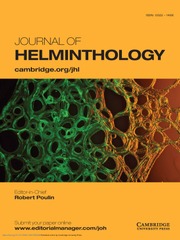No CrossRef data available.
Article contents
First molecular characterization of Proctoeces maculatus (Looss, 1901) (Digenea: Fellodistomidae) infecting blue mussels (Mytilus edulis) from the northeastern USA
Published online by Cambridge University Press: 14 February 2025
Abstract
The digenetic trematode Proctoeces maculatus is a cosmopolitan parasite that infects various invertebrates and fish hosts, including the blue mussel, Mytilus edulis, along the northeastern U.S. coast. Despite its impact on mussel fitness and the region’s aquaculture, little is known about the genetic diversity and connectivity of P. maculatus in this region. This study provides the first genetic characterization of P. maculatus populations in New England using the D1–D3 region of the 28S ribosomal RNA gene. Bayesian phylogenetic analysis and a haplotype network were used to assess genetic variation and connectivity across six localities in Maine, New York, and southern New England, and to compare these populations to global samples. Our results revealed distinct geographic structuring of P. maculatus haplotypes. The ME1 haplotype, unique to Maine, reflects either recent range expansion or isolation driven by environmental and biogeographic factors, such as Cape Cod’s role as a phylogeographic barrier. The most common haplotype, US1, was shared by populations in southern New England, New York, and a single specimen from Tunisia, indicating possible historical or anthropogenic connectivity. Two divergent haplotypes from Mississippi and Chile likely represent misidentifications or cryptic species. These findings support the hypothesis that P. maculatus is likely a cryptic species complex. Molecular evidence suggests connectivity across distant regions, emphasizing the role of host movement in parasite dispersal. Continued genetic studies, particularly from under-sampled regions, are needed to unravel the diversity and biogeography of P. maculatus and its potential impact on declining mussel populations.
- Type
- Short Communication
- Information
- Copyright
- © The Author(s), 2025. Published by Cambridge University Press


